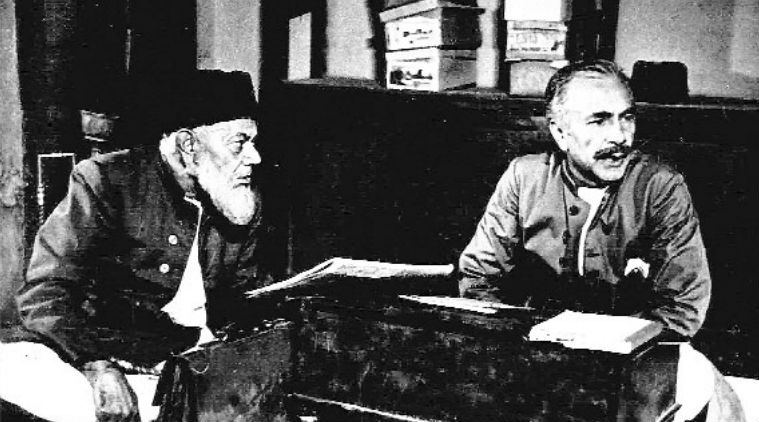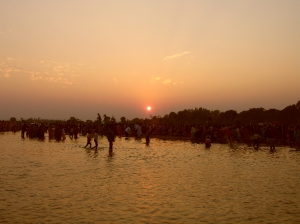‘Kashmir
is the Hamlet of my film,’ says Vishal Bhardwaj on Haider - See more
at:
http://indianexpress.com/article/entertainment/bollywood/kashmir-is-the-hamlet-of-my-film/99/#sthash.H6OuvnMw.dpuf
‘Kashmir
is the Hamlet of my film,’ says Vishal Bhardwaj on Haider - See more
at:
http://indianexpress.com/article/entertainment/bollywood/kashmir-is-the-hamlet-of-my-film/99/#sthash.H6OuvnMw.dpuf
‘Kashmir
is the Hamlet of my film,’ says Vishal Bhardwaj on Haider - See more
at:
http://indianexpress.com/article/entertainment/bollywood/kashmir-is-the-hamlet-of-my-film/99/#sthash.H6OuvnMw.dpuf
Written
by Harneet
Singh | New Delhi | Posted: October 5, 2014 1:00 am | Updated: October 5,
2014 9:13 am
Vishal Bhardwaj on Haider, how he nearly
reimagined Hamlet as an espionage thriller, composing songs at airports and
learning how to tell a story without words.
Haider is your third adaption of
a Shakespearean tragedy, after Maqbool and Omkara. Where does Shakespeare end
and Vishal Bhardwaj take over?
I don’t really know how to
answer this. Haider is an extension of what I have attempted in Maqbool and
Omkara. Haider doesn’t begin like he (Shakespeare) begins his play. I’ve turned
his third act into the first act. As a filmmaker, I wanted to make Hamlet in
Kashmir. In my film, in a way, Kashmir becomes Hamlet.
What was it about Kashmir that
made you set your Hamlet there?
It was the political turmoil and
the 25 years of tragedy of Kashmir that compelled me. Our way of looking at
Kashmir has either been cosmetic — only for shooting songs — or rhetoric, where
we show a man in a phiran, holding a Kalashnikov. Haider is the first film
where we see Kashmir from the inside. I don’t think we have made a mainstream
film about the issue. If this was Europe, we would have made 200 films on
Kashmir. Hollywood is still making films on the Nazi era. Every year, there is
a film on World War I. Now, they are telling stories of Iraq, even television
has Homeland. They have a take on “human conflicts” lekin hum log toh chori se
baaz nahin aaye hain (but we have still not gotten over the theme of theft).
Hum abhi bhi thieves ki filmein bana rahe hain (We are still making films about
thieves). The human conflict in Kashmir drew me. I’ve set Haider in 1995, when
militancy was at its peak. I wanted to observe the human tragedy that a regular
middle-class family went through. What happened to the families that didn’t
move away? What happened to the mother who was a teacher, the father who was a
doctor, the uncle who was a lawyer? Till now, we have heard points of view from
this side or that side. We know the two extremes but the tension is always in
the middle — what about the people hanging between the two extremes of the
rope?
How did the collaboration with
journalist-author Basharat Peer, who co-wrote Haider, work out?
My wife, Rekha, was reading
Basharat’s memoir, Curfewed Night. One night, I saw her crying while reading
it. She said, “Hila diya mujhe iss book ne (This book shook me).” I had just
returned from the US and was severely jetlagged, so I didn’t read the book. But
Hamlet was very much on my mind. In fact, I was developing the play as a
contemporary espionage thriller with author Stephen Alter. We wrote a 30-page
synopsis, which I sent to Gulzarsaab to read. He liked it, but asked me, “Where
is the tragedy of Hamlet in this thriller?” He was right. What more could I
tell about a RAW (Research and Analysis Wing) agent? How much do we really know
about the real life of an agent? The Official Secrets Act is so stringent that
it’s tough to tell an authentic account of a RAW agent. I was heartbroken, but
Hamlet was still on my mind. That’s when I remembered Basharat’s book. I
contacted him and we started work. The authentic feel in Haider is because of
him. There are so many little things in the film which only an insider could
bring in. If Basharat was not a part of the film, it wouldn’t be made or it
wouldn’t be made this way.
You worked with Tabu after a
decade since Maqbool. Is it easy for a director and actor to pick up the
chemistry from where they left it?
There is always chemistry
between people. The actor-director equation comes in later. If the friendship
remains, then you can take it from where you left. Tabu se mere jhagde bhi
bahut huye… saalon baat bhi nahin hui… par phir ek din baat shuru ho gayi.
Hamari dosti aisi hai. (Tabu and I had a lot of fights… we didn’t speak to
each other for years… but then one day we started talking again. Our friendship
is such). With some people you just work professionally, like Saif (Ali Khan) —
I did Omkara with him and that’s about it. With Tabu and Irrfan, it’s
friendship.
But do you ever miss working
with a particular actor? Like Gulzarsaab once told me that he missed working
with Sanjeev Kumar.
I miss Priyanka Chopra, both as
an actor and as a person. When we work together, it feels as if main apne
school ke bachpan ke kissi dost ke saath kaam kar raha hoon (I am working with
one of my childhood friends from school). I also miss Irrfan, whose sense of
cinema is at another level. Sometimes, an actor takes a performance to another
level, and as a director you miss him the most.
Which actor surprised you the
most?
Pankajji (Kapur). He took
Abbaji’s role in Maqbool to another level. The small gestures he added to his
performance, the little things he did, the way he got Abbaji’s walk, he stunned
me. Pankajji is the kind of actor who takes from your work, adds his own
brilliance to it and shows how great your work is.
How do you strike a balance
between writing, directing, producing, composing and singing? What do you enjoy
the most?
I’m always shifting gears in my
head. I’m thinking about something or the other all the time. I enjoy my music
the most. It gives me peace and is my greatest love.
Do you start composing while
writing a film or after you have written it?
It begins during the writing. In
Omkara, all the songs were composed while writing the script. There is no
regimented process of how I make music. Mere saare gaane yunhi chalte phirte
bante hain (All my songs are composed just like that). Sometimes, they are
made because I want to use them cinematically at a crucial moment in a film,
like the lullaby Jag jaa ri gudiya in Omkara, which Omkara sings to wake
his wife up. I knew that he would sing it again during the climax, so I needed
to compose a lullaby. In Haider, I needed the grave-diggers song, so I made Aao
naa. I wrote some lines, but Gulzarsaab only retained Aao naa and changed the
rest. You’ll be surprised to know that Gulzarsaab and I have never composed a
song, sitting at a place. All our songs have been written and composed at
airports or in cars. Most of the times, he is standing in a queue saying the
lines, while I sing it back to him on the phone. I will never forget how we
made Ibn-e-batuta for Ishqiya. We were standing in a long queue waiting to
board a flight. By the time we got to the bus, we had the mukhada ready. Inside
the plane, we made the antara, and by the time we landed, we had the entire
song.
Which song has been the toughest
to compose for you?
That would be Haider’s Bismil.
It took over four months to compose. I recorded it in Srinagar, Mumbai and
London, but I couldn’t get what I wanted. This is ‘The Mousetrap’ (the play
within the play) of Hamlet. This is when Haider re-enacts the murder, but I had
to do that while retaining the poetic flavour. It was tough.
How do you sustain your
creativity?
By taking as many trips to
Landour (near Mussoorie) as I can. Once I’m in Landour, I don’t do anything. I
just walk and meet Ruskin (Bond). I want to shift there permanently. Now, there
is no compulsion to work from Mumbai because all you need is a computer to work
from anywhere.
How do you view your growth as a
filmmaker?
I’ve learnt how to convey
without words. Earlier, my films were too verbose. In Haider, I have used a lot
of silence. I even keep my background music minimalistic.
Is there a filmmaking rule you
have had to unlearn?
In filmmaking, less is more. The
more you try to explain, the more you mess it up.
If you were to throw a dinner
party and invite five of your favourite characters, who all would you call?
Maqbool’s Abbaji, 7 Khoon Maaf’s
Susanna, Kaminey’s Guddu, the witch from Makdee and Omkara. I can already see
Abbaji and Omkara coordinating and planning something. I can see the witch and
Susanna sizing each other up.
Do you follow the work of your
contemporaries? Do you have any favourites?
I don’t keep a track of anyone
as such, but some of the recent films that I loved are Ship of Theseus, Dibakar
Banerjee’s short film Star in Bombay Talkies and The Lunchbox. I also really
liked Dibakar’s Oye Lucky! Lucky Oye! as well as Anurag Kashyap’s Black Friday
and Dev.D. Anurag really surprised me with Dev.D. When he first told me he
wanted to do a modern adaptation of Devdas, I tried to talk him out of it.
To me, Devdas’s is a boring story. What does this guy do the entire day? Just
drink and cry? That’s boring.
What would your Devdas be like?
My character would become a
gangster in love and not sulk in booze.
You have so many scripts ready.
Some of those were announced, too, but never took off. Do you have any plans to
revisit them?
Jo filmein bante bante reh jaati
hain (The films
that never get made), they are your unhealed wounds. They don’t bother you when
you are occupied with other things, but when you are alone, they pinch you. Out
of all my earlier scripts, I would love to make Barf and Dream Sequence.



















 As Dr. Chandraprakash Dwivedi returns to the turnstiles with a
political satire, the director known for his period sagas, talks about
the contemporary politics and his ideological concerns
As Dr. Chandraprakash Dwivedi returns to the turnstiles with a
political satire, the director known for his period sagas, talks about
the contemporary politics and his ideological concerns  For
a man who devotes years to research, Dwivedi accepts the Muslim
household was a new turf for him. “Thankfully, Ram Kumar comes from
Fatehpur where the story is based. So the mood was there in the writing
itself. I also come from Rajashan and understand the cultural ethos of
the region.”
For
a man who devotes years to research, Dwivedi accepts the Muslim
household was a new turf for him. “Thankfully, Ram Kumar comes from
Fatehpur where the story is based. So the mood was there in the writing
itself. I also come from Rajashan and understand the cultural ethos of
the region.”